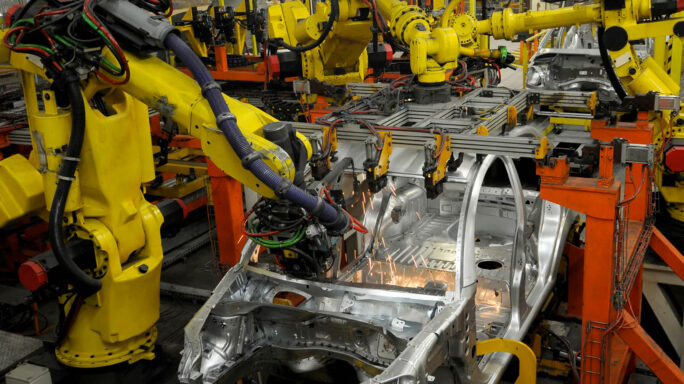Technology & Innovation
How Industry 4.0 can help create the factory of the future

Through digital transformation, your manufacturing firm can take advantage of productivity and efficiency gains via Industry 4.0.
You can look ahead to a factory of the future – connecting information so intelligent machines can collaborate with each other, run by a team of analytical, well-trained workers.
It’s a centre of innovation—the hub of a supply chain that combines customers, suppliers, distributors and partners with advanced analytical systems. This can lead to “perfect production” with minimal downtime, neglect, waste and inefficiency.
With Industry 4.0, major technologies are coming to fruition into the same time. The manufacturing industry is being disrupted by the integration of the virtual and physical worlds.
It’s the age of technology where the Internet of Things (IoT), big data, advanced analytics and robotics are emerging. It’s the age of the “smart factory”, where data from connected operations is used to learn and adapt to ever-changing demands.
In this article, we take a look at what Industry 4.0 is, how you can start using it within your manufacturing firm and how to take the steps towards creating your own factory of the future.
eBook: Streamline your business operational process
Discover how 3 technology trends can help you overcome today’s top 4 manufacturing industry challenges.

Industry 4.0 technologies to understand
Below we explore the key technologies that make up Industry 4.0 and are worth understanding so you can take steps to implement them within your manufacturing firm.
Internet of Things (IoT)
IoT is the fusion of physical objects such as software, sensors and electronic items with the internet and machine-enabled data collection and transfer.
IoT supports real-time communication, initiating physical systems. It allows traditional supply chains to become more digitised and connected—completely integrated ecosystems that are fully transparent to the contributing marketing, product development, manufacturing and distribution departments.
Examples of IoT in action include the facilitation of applications and production flow in factories, as they can automatically monitor development cycles. You’ll also see them in warehouses and for use in managing inventory.
Big data and advanced analytics
The way businesses read and analyse the massive amount of data that comes with IoT is vital, especially if it involves critical events such as power outages or an attempted data breach.
In manufacturing, the availability of data from product development, production and testing, for example, can add new dimensions, allowing targeted innovation, marketing and decision-making.
Robotics
Robots are already used extensively in the manufacturing world—mechanical arms on assembly arms is one such example.
Industry 4.0 could see the contribution from robots increase. They could take ownership of manufacturing processes and bring products to customers by themselves, due to computing and communication systems linked to physical systems.
Simulations, 3D printing and augmented reality
Already commonplace, goods are virtually modelled and tested, saving time and reducing the materials, efforts and money spent.
Through 3D printing, we can see the creation of customised, complex and lightweight designs at remarkable speeds. Meanwhile, augmented reality could play an important role where employees are trained on the job far more effectively than via paper or monitors.
Gain a competitive advantage
Only 30% of manufacturers investing in transforming their digital operations will reach their full potential, held back by outdated business models and technology.
By pivoting your strategy towards smarter analytics and an optimal organisational structure, your manufacturing firm can use Industry 4.0 to create a competitive advantage and improve your product offering, loyalty and satisfaction among the customer base.
The four pillars for an effective Industry 4.0 strategy are detailed below, along with what you need to do to bring them to life in your factory:
1. People
Tasks once managed by people are increasingly being handed over to robots and artificial intelligence (AI), but humans will still play a huge part. The adoption of Industry 4.0 means there must be a major shift in skills, recruitment and training to take advantage of new technology.
Your team will need to blend traditional manufacturing skills with new ones and requirements such as a knowledge of automation, data, analytics, programming and software.
2. Software
Hardware is nothing without software, and it’s the creation of applications by your software partners that will drive Industry 4.0. Leveraging integrated systems that can support all areas of your business—led by inventory, production, sales, accounting and finance—is vital.
This will provide a single database and core functionality, which allows you to automate your business operations and provide real-time information.
3. Hardware
Software is also nothing without hardware. The increasing value of software is dependent on your hardware getting faster and better. Amid the talk of a virtual factory, your products still actually need to be made—that can’t happen without machinery.
4. Connectivity
To differentiate your business, you need to focus on serving customers. To do this, you must explore new ways of delivering innovative products and services. This might mean cloud connectivity to underpin an Industry 4.0 strategy for optimal efficiency.
Creating an innovative mindset
People will be the first priority when it comes to an Industry 4.0 digital transformation. Change must start with having teams buy into an innovative mindset and you have a responsibility to drive this forward.
Robert Joseph, the director of industrial strategy for Industry 4.0 for Stanley Black & Decker, says manufacturers are innovative nature, especially people who work on the shop floor.
He says: “If something isn’t working right or if something needs to be performing better or faster, manufacturers figure out what’s causing the problem in order to get it working correctly and keep the lines moving.
“The challenge is today they’re inundated with so much change and it’s hard to keep track, and it’s kind of scary when the latest news is that technology will make manufacturing jobs go away.
“Business leaders should take that emotion into account when talking about Industry 4.0 and introducing new technology.
“This transformation is equally about upskilling your employees and growing their career paths alongside the company—especially for employees who have been in manufacturing for decades and have seen technology transition the industry over the years.”
Implementing an Industry 4.0 culture
To keep your manufacturing firm moving in the right direction as you adopt Industry 4.0, you need to implement a culture where change is expected. As an outcome, individuals in the business should have the room and resources to learn how to work through those changes and develop as a team.
Joseph adds: “Everybody doesn’t need to know everything about AI for example, but they should all have access to learn about AI and how it works to be comfortable with using it to make their jobs easier.
“Leaders should be facilitating a culture of learning and how to learn from a data and technology perspective so their workforce can keep up with how fast the climate is changing.”
Joe Marino, principal at InfiniteIQ Consulting, says new lines of communication and collaboration can create a new sense of solidarity that bodes well for company culture and the success of an Industry 4.0 transformation.
He says: “Organisational issues and culture will kill any project before it gets started. Breaking down silos and getting teams to work together in ways that they haven’t before creates a connection within the company culture that’s rare in today’s gig economy.
“I’ve never seen a successful transformation where employees feel like they are disposable. Executives have to make sure that their employees feel the betterment of the company is for the betterment of the individual and vice versa.”
Digital transformation and Industry 4.0 takeaways
If your business isn’t already planning for or taking part in the fourth industrial revolution, you should immediately look at understanding how digital transformation fits into your business strategy.
You must also:
- Understand the capabilities and limitations of your existing IT architecture, how it can support a manufacturing business, and develop ways to overcome Industry 4.0 challenges.
- Make use of Industry 4.0 implementation methodologies and checklists, making you know how to create, convert, implement, access, test, measure, define and design systems.
- Understand the transformative technology that will modernise your business systems and make sure to stay current in your search for growth.
Make sure you’re prepared to meet today’s manufacturing challenges.
eBook: Streamline your business operational process
Discover how 3 technology trends can help you overcome today’s top 4 manufacturing industry challenges.







